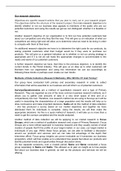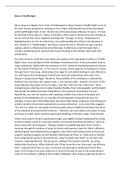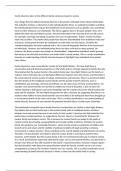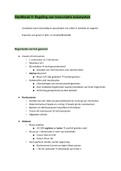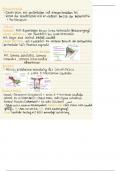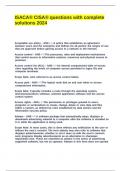Problem 6 – causation and strobe statement
Learning goals
1) What is the DAG?
Directed acyclic graphs (DAGs) are graphs representing a
set of causal assumptions.
Rules:
- Direct causal relationships are represented by
arrows
- Cause always precede their effect no loops
- Included all common causes of the exposure and
disease of interest, also unknown/unmeasured
causes
2) When and how should you use the DAG? (steps)
DAGs help us to understand and identify:
- Mediation
- Confounding
- Collider bias
DAGs help us identify which factors to minimally adjust for in the analysis.
STEPS DAG ANALYSIS
1. Identify primary confounder of interest (could be directly or indirectly!) shortest path =
primary
a. Could be indirect to both the exposure and outcome!!
2. Check whether any of the other covariates are (direct) descendants of the exposure. Do not
adjust for these intermediate factors! (does not count as a path) put a box around it
3. Delete all non-ancestors of the exposure, the outcome and the primary confounder. This are
variables that are not fully included in the DAG
4. Remove all arrows emanating from the exposure (arrows that go away from the exposure)
(direct effect of E) do not remove the mediator!
5. Connect any two parents with a common child (connect the variables that are going to a
collider)
6. Strip arrow heads
7. Delete the primary confounder of interest adjusting for this variable
8. Is the exposure disconnected from the outcome? No; remove the variable that result in the
connection adjusting for this variable
3) What is a mediator, collider, confounder? How to identify and adjust for?
MEDIATOR
A mediator is a (direct) descendent of the exposure
- Between the exposure and outcome variable
, Problem 6 – causation and strobe statement
- PA BMI diabetes
It depends on your goal if you want to adjust for a mediator. Are you interested in the total effect or
the direct effect? The adjustment removes the indirect effect; so only the direct effect will stay in.
CONFOUNDING
A confounder is a common cause of the exposure and the outcome
smoking is a confounding factor
primary confounder = variable that has an effect on both the exposure and outcome variable
You should adjust for the confounder in the statistical analysis.
COLLIDER
A collider is a common effect of two (or more) variables; can not be the outcome or exposure
variable.
Acceptable for dating is the collider
You should not adjust for a collider! If you do adjust you induces an association between the causes
of the common effect, which is collider (stratification) bias.
4) What is ancestor, descendant, children, parents?
Ancestor = go towards the variable of interest (in the steps you ancestor of the outcome) (direct or
indirect)
Descendant = go away from the variable of interest (could be direct and indirect)
Children = collider
Parents = the variables that go to the collider (direct)
Single ancestor could also be a parent if it is direct
5) What is the Rothman’s pie chart?
In nature it is very rare that one factor results in one particular disease. A combination of events can
lead up to an outcome.
Learning goals
1) What is the DAG?
Directed acyclic graphs (DAGs) are graphs representing a
set of causal assumptions.
Rules:
- Direct causal relationships are represented by
arrows
- Cause always precede their effect no loops
- Included all common causes of the exposure and
disease of interest, also unknown/unmeasured
causes
2) When and how should you use the DAG? (steps)
DAGs help us to understand and identify:
- Mediation
- Confounding
- Collider bias
DAGs help us identify which factors to minimally adjust for in the analysis.
STEPS DAG ANALYSIS
1. Identify primary confounder of interest (could be directly or indirectly!) shortest path =
primary
a. Could be indirect to both the exposure and outcome!!
2. Check whether any of the other covariates are (direct) descendants of the exposure. Do not
adjust for these intermediate factors! (does not count as a path) put a box around it
3. Delete all non-ancestors of the exposure, the outcome and the primary confounder. This are
variables that are not fully included in the DAG
4. Remove all arrows emanating from the exposure (arrows that go away from the exposure)
(direct effect of E) do not remove the mediator!
5. Connect any two parents with a common child (connect the variables that are going to a
collider)
6. Strip arrow heads
7. Delete the primary confounder of interest adjusting for this variable
8. Is the exposure disconnected from the outcome? No; remove the variable that result in the
connection adjusting for this variable
3) What is a mediator, collider, confounder? How to identify and adjust for?
MEDIATOR
A mediator is a (direct) descendent of the exposure
- Between the exposure and outcome variable
, Problem 6 – causation and strobe statement
- PA BMI diabetes
It depends on your goal if you want to adjust for a mediator. Are you interested in the total effect or
the direct effect? The adjustment removes the indirect effect; so only the direct effect will stay in.
CONFOUNDING
A confounder is a common cause of the exposure and the outcome
smoking is a confounding factor
primary confounder = variable that has an effect on both the exposure and outcome variable
You should adjust for the confounder in the statistical analysis.
COLLIDER
A collider is a common effect of two (or more) variables; can not be the outcome or exposure
variable.
Acceptable for dating is the collider
You should not adjust for a collider! If you do adjust you induces an association between the causes
of the common effect, which is collider (stratification) bias.
4) What is ancestor, descendant, children, parents?
Ancestor = go towards the variable of interest (in the steps you ancestor of the outcome) (direct or
indirect)
Descendant = go away from the variable of interest (could be direct and indirect)
Children = collider
Parents = the variables that go to the collider (direct)
Single ancestor could also be a parent if it is direct
5) What is the Rothman’s pie chart?
In nature it is very rare that one factor results in one particular disease. A combination of events can
lead up to an outcome.


